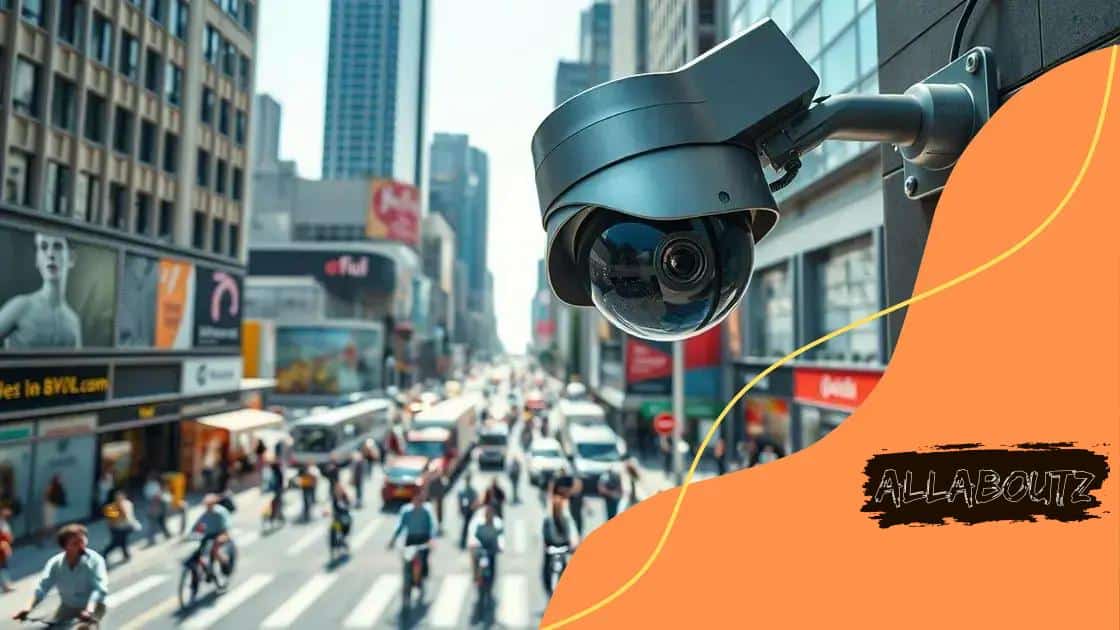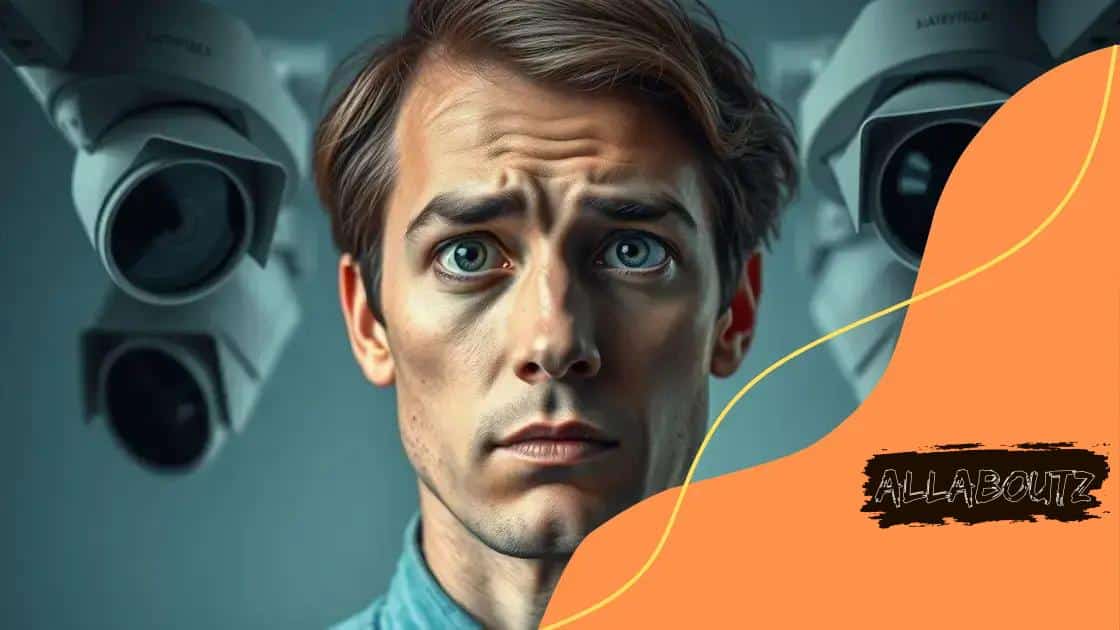The role of facial recognition in enhancing public safety

The role of facial recognition in enhancing public safety involves its use in crime prevention, rapid identification of suspects, and integration into smart city initiatives, while also raising privacy and ethical concerns.
The role of facial recognition in enhancing public safety is becoming more significant as cities look for effective ways to ensure community security. Have you ever wondered how it affects our daily lives?
Understanding facial recognition technology
Understanding facial recognition technology is essential to grasping how it enhances public safety. This technology uses algorithms to identify and verify individuals based on their facial features. By analyzing images taken from cameras, it can match faces against databases to find potential matches.
How Facial Recognition Works
The process begins with an image capture, where a camera takes a picture of a person’s face. Next, the software extracts key features, such as the distance between the eyes or the shape of the jawline. Then, it converts these features into a numerical format that can be compared with existing data.
Key Applications
Facial recognition shows remarkable potential in various sectors. For instance:
- Law enforcement agencies use it to quickly identify suspects.
- Airports enhance security by verifying passengers before boarding.
- Retail stores can track customer behavior and prevent theft.
Moreover, as it becomes more prevalent, ethical considerations arise. People often wonder about their privacy rights regarding facial recognition data. Policymakers need to balance safety and privacy to ensure that the technology does not infringe on personal freedoms.
Challenges and Limitations
Despite its benefits, facial recognition technology faces challenges. Occasional inaccuracies can lead to wrongful identifications. Factors such as low lighting or camera angle can adversely affect accuracy. Thus, continuous improvement of algorithms is necessary to enhance reliability.
Public perception is another hurdle. Many individuals express concerns about surveillance and the potential for misuse. Therefore, transparent practices and regulations are paramount to gaining public trust in this technology.
How facial recognition improves law enforcement
How facial recognition improves law enforcement is a crucial aspect of modern policing. This technology provides law enforcement with powerful tools to enhance public safety and solve crimes efficiently. By utilizing facial recognition systems, police can quickly identify suspects and streamline investigations.
Identification of Suspects
One of the primary benefits is the rapid identification of individuals involved in criminal activities. When video footage is available, officers can compare faces against databases of known offenders. This speeds up the process significantly, reducing the time needed to track down suspects.
Crime Prevention
Facial recognition contributes to proactive policing. By deploying cameras in strategic locations, law enforcement can monitor public spaces and detect suspicious behavior in real-time. This immediate response capability helps deter potential crimes before they happen.
Moreover, successful identification can lead to higher conviction rates. When officers have reliable evidence connecting a suspect to a crime scene, it strengthens their case in court. This advancement promotes justice and reinforces community trust in law enforcement.
Integrated Systems
Facial recognition systems can be integrated with existing surveillance technology. This means that police departments can make the most of their resources by enhancing video feeds to quickly find persons of interest. With advanced analytics, the data collected can reveal patterns, contributing to crime trends and hotspots.
- Increased speed of investigation
- Better allocation of resources
- Enhanced collaboration between agencies
However, while the benefits are significant, there are also challenges. The accuracy of facial recognition can vary, and false positives may occur. It’s essential for law enforcement to balance the use of technology with ethical considerations to ensure fair treatment of individuals.
Privacy concerns surrounding facial recognition

Privacy concerns surrounding facial recognition have become increasingly significant as the technology becomes more widespread. Many people worry about how their personal data is collected and used without their consent. This concern is crucial in discussions about the impact of facial recognition on civil liberties.
Data Collection Practices
Facial recognition systems often rely on vast databases of images. These images can come from social media, public surveillance cameras, and other sources. This extensive gathering raises questions about what information is stored, who has access to it, and how it’s protected.
Potential for Misuse
The possibility of misuse of facial recognition data is a major concern. For example, without strict regulations, businesses and governments may use this technology to track individuals without their knowledge. This surveillance can lead to a range of issues, including harassment, discrimination, or breaches of privacy.
Additionally, there are worries about false positives. If the technology incorrectly identifies someone as a suspect, it could lead to significant consequences. This scenario illustrates why transparency in facial recognition technology is essential.
Public Opinion and Regulation
Public opinion is often divided on the use of facial recognition. Some people appreciate the safety benefits but are uneasy about privacy violations. This division creates a demand for clear regulations to protect individuals’ rights while still allowing law enforcement to utilize these tools effectively.
- Need for strict oversight
- Importance of informed consent
- Transparency in data use
As facial recognition technology evolves, jurisdictions worldwide are considering policies to balance safety and privacy. Implementing regulations can help satisfy concerns while maintaining the advantages of enhanced security measures.
Real-world applications in public safety
Real-world applications in public safety demonstrate how facial recognition technology can enhance security in various environments. This technology is increasingly being adopted by organizations and cities to address safety concerns and improve emergency response.
Smart Cities
Many modern cities are utilizing facial recognition in smart city initiatives. Through the installation of cameras in public areas, they can monitor activities and identify potential threats. This capability allows authorities to respond quickly to incidents, thereby ensuring public safety.
Transportation Hubs
Transportation hubs, like airports and train stations, have started using facial recognition to streamline security processes. Passengers can be verified quickly as they pass through security checks. This not only speeds up the process but also enhances accuracy, reducing the chances of security breaches.
- Faster boarding experiences
- Efficient crowd management
- Enhanced surveillance for suspicious activity
Furthermore, law enforcement agencies benefit from real-time data provided by facial recognition systems. They can track suspects in crowded places or quickly locate missing persons. By deploying drones equipped with facial recognition, authorities can monitor large events, ensuring safety and order.
Retail Security
In the retail sector, businesses are implementing facial recognition for loss prevention. By identifying known shoplifters, stores can act before theft occurs. This proactive approach not only saves money but also creates a safer shopping experience for customers.
Additionally, integrating this technology into customer service allows businesses to recognize loyal customers and tailor experiences. This personalization enhances customer satisfaction and strengthens brand loyalty.
Future trends in facial recognition
Future trends in facial recognition show exciting possibilities as technology evolves. As advancements continue, facial recognition will likely become more accurate, efficient, and integrated into various aspects of daily life.
Enhanced Accuracy
One major trend is the improvement in accuracy. New algorithms are being developed to reduce false positives and ensure that systems can recognize faces even in challenging conditions, such as poor lighting or unusual angles. This heightened precision is crucial for applications in security and law enforcement, where the stakes are high.
Integration with Artificial Intelligence
Another significant trend is the integration of artificial intelligence (AI) with facial recognition systems. AI can analyze vast amounts of data quickly, learning and adapting to new situations. This will lead to smarter surveillance systems that can identify patterns and predict potential security threats before they occur.
- Real-time analytics for immediate responses
- AI-driven insights for law enforcement
- Personalized experiences in retail environments
Moreover, the growth of smart devices means facial recognition technology will be embedded in more gadgets. From smartphones to home security systems, users will experience seamless interactions, improving convenience and safety.
Ethical Developments
As technology advances, ethical considerations will also be more prominent. There is a growing demand for regulations to ensure that facial recognition is used responsibly. These regulations will help protect individual rights and privacy, ensuring that the benefits of technology do not come at the cost of personal freedoms.
Additionally, public awareness about how data is collected and used will increase. Companies providing facial recognition services will need to maintain transparency about their practices, building trust with users.
FAQ – Frequently Asked Questions about Facial Recognition Technology in Public Safety
How does facial recognition improve public safety?
Facial recognition technology enhances public safety by quickly identifying suspects, monitoring public spaces, and preventing crime before it happens.
What are the ethical concerns associated with facial recognition?
Ethical concerns include privacy violations, data security, and the potential for misuse of the technology by businesses or government agencies.
How accurate is facial recognition technology?
While accuracy has improved with advancements in algorithms, challenges such as poor lighting or varied angles can still lead to false positives.
What future trends can we expect in facial recognition technology?
Future trends include enhanced accuracy, integration with artificial intelligence, and stronger regulations to protect individual privacy rights.





